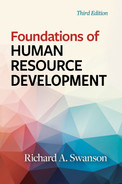Figures
1.1 Human Resource Development: Definitions, Components, Applications, and Contexts
1.2 Human Resource Development Definitions over Time
2.2 Five Phase Human Resource Development in Context of the Organization and Environment
2.4 Nine Performance Variables
4.1 The Psychological Life Span
4.2 Theory-Research-Development-Practice Cycle
5.1 Institutional Boundaries of the HRD Host Institutional System
5.3 Human Resource Development: Definitions, Components, Applications, and Contexts
5.4 Model of Human Resource Development within the Organization and Environment
5.5 The Theoretical Foundations of Human Resource Development
6.1 Foundational Psychological Theories and Their Contribution to HRD
6.2 A Model of Human Capital Theory
6.3 A Cross-Section of the Systems Leg: Contributions of Systems Theory
6.4 Challenges Posed by Systems Theory as a Foundation for HRD
7.1 Comparison of the Learning and Performance Paradigms
8.1 Well-Known Models of Organizational Effectiveness
8.3 Perspectives on the Domain of Performance
8.4 Human Capital Performance Matrix and Examples
8.6 White Space Performance Model Questions—Rummler and Brache
8.7 Diagnosing Performance Process
8.8 Performance Diagnosis Matrix Questions—Swanson
8.9 Organization Development Performance Model—Cummings and Worley
8.10 Job Performance Components—Campbell
8.11 Behavior Engineering Model—Gilbert
9.2 The Information-Processing Model
9.5 Process Design Steps of Andragogy
9.6 Andragogy in Practice Model
9.7 Experiential Learning Model—Kolb
9.8 Functions of Schooling and Learning Settings
9.9 Learning Organization Action Imperatives—Watkins and Marsick
9.10 Learning Organization Performance Model
10.1 Framework for Information and Communication Technology Use in Human Resource Development
10.2 Traditional versus Competence-Based Training
11.2 Informal and Incidental Learning Model
11.3 The Model of Interservice Procedures for Instructional Systems Development (ISD)
11.4 Training for Performance System
11.5 Steps within the Process Phases of the Training for Performance System
11.9 The Structured On-the-Job Training System
11.10 Work-Based Learning Pyramid
12.1 Comprehensive Process of Documenting Workplace Expertise
12.2 The Basic Components of Expertise
12.3 Competence as a Subset of Expertise
12.4 Selling Homes Expertise Illustration
13.3 Process-Referenced Expertise
14.1 Selected Organization Development Definitions
14.2 Ten Key Outcome (Dependent) Variables from Definitions of Organization Development
14.3 Strategic Organizational Planning (SOP)
14.4 Definitions of Selected Organization Development Terms
14.6 Organization Development Process Model
14.7 Organization Development for Performance System
15.1 Types of Organizational Change
15.3 Process Theories of Organizational Development and Change
15.4 Process Improvement and Management Methodology
15.5 Relationship Map for Computec, Inc.
15.6 Model of Organizational Performance and Change
15.8 The Three Universal Processes of Managing for Quality
16.1 Shewart’s Plan-Do-Check-Act Cycle
16.2 Process Improvement and Process Innovation
16.3 The Five Phases of the Benchmarking Process
16.4 Cultural Values and Organization Customs
16.5 Common Types of Sensitivities and Associated Distortions in Performance
17.1 Ten Schools of Strategic Thinking
17.2 Using Scenario Options to Examine Organizational Elements
17.3 Theory of Scenario Development
17.4 Strategic Organizational Planning (SOP)
17.5 Human Resource Development’s Contribution in Supporting and Shaping SOP
18.1 Return on Investment Methodology Process Model
18.2 Using the Balanced Scorecard to Find Background Information
18.3 Lag and Lead Performance Measures
18.4 Skandia Corporation Metrics
18.5 Results Assessment Process
18.6 Framework and Key Questions for Assessing HRD Financial Benefits
19.1 Comparative Study Framework for Human Resource Development
19.2 Stanford d.School Design Thinking Model
19.3 Project Management, HRD, and Business (PMHRDB) Partnership Model
20.1 The Employee Career Development Integration Model
21.1 Samples from Virtual Reality–Based Simulations
21.2 Samples from AR-Based Simulations
